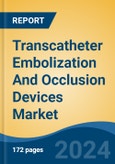Non-Coil is the fastest growing segment, North America is the largest regional market
Speak directly to the analyst to clarify any post sales queries you may have.
10% Free customizationThis report comes with 10% free customization, enabling you to add data that meets your specific business needs.
Key Market Drivers
The burgeoning global prevalence of target diseases significantly underpins the expansion of the transcatheter embolization and occlusion devices market. Conditions such as cardiovascular disease, cancer, and aneurysms necessitate advanced therapeutic interventions, directly increasing the demand for effective treatment modalities. For instance, according to the Journal of the American College of Cardiology (JACC), in 2023, there were 626 million prevalent cases of cardiovascular disease globally, a substantial patient population often requiring embolization or occlusion procedures.Key Market Challenges
A substantial challenge impeding the expansion of the global transcatheter embolization and occlusion devices market is the scarcity of adequately trained interventional specialists. The intricate nature of transcatheter procedures necessitates a high level of expertise and specialized training, which directly restricts the volume of procedures performed and consequently limits market penetration. This limitation is particularly pronounced in developing healthcare systems where training infrastructure may be less established. The absence of sufficient training programs directly impacts the availability of qualified practitioners capable of utilizing these advanced devices.Key Market Trends
Artificial intelligence integration is profoundly reshaping transcatheter embolization and occlusion procedures through enhanced planning, guidance, and analysis. This technology improves diagnostic precision and optimizes treatment, fostering more effective patient outcomes. A EuroAIM/EuSoMII 2024 survey of European Society of Radiology members indicated 47.9% of respondents actively employed AI systems in their clinical practice. This demonstrates a clear adoption trajectory. Clinical utility is further exemplified by a June 2025 study in the Journal of Neurointerventional Surgery, where an AI-based system, Neuro-Vascular Assist by iMed technologies, facilitated liquid embolization procedures. The system achieved 100% precision and 92.0% recall in real-time agent spread notification, prompting operator intervention in 28.3% of instances, thereby enhancing procedural safety and control.Key Market Players Profiled:
- Boston Scientific Corp
- Terumo Corp
- Medtronic PLC
- DePuy Synthes Inc
- Stryker Corp
- Cordis Corp
- Abbott Laboratories Inc
- Pfizer Inc
- Sirtex Medical Inc
- Nordion Inc
Report Scope:
In this report, the Global Transcatheter Embolization And Occlusion Devices Market has been segmented into the following categories:By Product:
- Coil
- Non-Coil
By Application:
- Peripheral Vascular Disease
- Oncology
- Neurology
- Urology
- Others
By Region:
- North America
- Europe
- Asia-Pacific
- South America
- Middle East & Africa
Competitive Landscape
Company Profiles: Detailed analysis of the major companies present in the Global Transcatheter Embolization And Occlusion Devices Market.Available Customizations:
With the given market data, the publisher offers customizations according to a company's specific needs. The following customization options are available for the report.Company Information
- Detailed analysis and profiling of additional market players (up to five).
This product will be delivered within 1-3 business days.
Table of Contents
Companies Mentioned
The companies profiled in this Transcatheter Embolization and Occlusion Devices market report include:- Boston Scientific Corp
- Terumo Corp
- Medtronic PLC
- DePuy Synthes Inc
- Stryker Corp
- Cordis Corp
- Abbott Laboratories Inc
- Pfizer Inc
- Sirtex Medical Inc
- Nordion Inc
Table Information
| Report Attribute | Details |
|---|---|
| No. of Pages | 185 |
| Published | November 2025 |
| Forecast Period | 2024 - 2030 |
| Estimated Market Value ( USD | $ 3.52 Billion |
| Forecasted Market Value ( USD | $ 5.26 Billion |
| Compound Annual Growth Rate | 6.9% |
| Regions Covered | Global |
| No. of Companies Mentioned | 10 |









